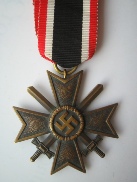 |
| Parachute Regiment Cap Badge 1942- |
 |
| Rare 1st pattern Parachute regiment badge 1941- |
The success of German airborne operations at the begining of WW2 prompted the Prime Minister, Winston Churchill, to direct the war office to invetigate the possibility of creating a corps of 5000 parachute troops. On June 1940, No. 2 Commando was transfered to parachute duties and on 21 November, re-designated the 11th special Air Battalion, with a parachute and glider wing. The Battalion took part in the first British Airbourne operation, Operation Colossus, on Februaury 1941. The Battalion was later re-designated the 1st Parachute Battalion in September and was asssigned to the 1st Parachute. The Army Air Corp was created as the command formation of the Parachute Regiment and the Glider Pilot Regiment.
The Parachute regiment badge consists of a parachute with a pair of wings either side. A Kings crown is fixed above the parachute and this is summonted by a lion statant gaurdant. The badge is of white metal and is attached to a beret with two lugs. The 1st pattern badge has a voided crown and legsof the lion. The 2nd pattern is not voided. This badge is far more common. The Parachute Regiment Badge was worn on a maroon coloured beret. Major-General F.A.M. 'boy' Browning who had been appointed General officer comanding Airbourne Forces in November 1941 was responsible for the adoption of the maroon coloured beret.










